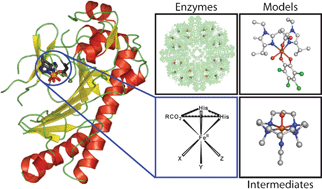Iron-containing enzymes are one of Nature’s main means of effecting key biological transformations. The mononuclear non-heme iron oxygenases and oxidases have received the most attention recently, primarily because of the recent availability of crystal structures of many different enzymes and the stunningly diverse oxidative transformations that these enzymes catalyze. The wealth of available structural data has furthermore established the so-called 2-His-1-carboxylate facial triad as a new common structural motif for the activation of dioxygen. This superfamily of mononuclear iron(II) enzymes catalyzes a wide range of oxidative transformations, ranging from the cis-dihydroxylation of arenes to the biosynthesis of antibiotics such as isopenicillin and fosfomycin. The remarkable scope of oxidative transformations seems to be even broader than that associated with oxidative heme enzymes. Not only are many of these oxidative transformations of key biological importance, many of these selective oxidations are also unprecedented in synthetic organic chemistry. In this critical review, we wish to provide a concise background on the chemistry of the mononuclear non-heme iron enzymes characterized by the 2-His-1-carboxylate facial triad and to discuss the many recent developments in the field. New examples of enzymes with unique reactivities belonging to the superfamily have been reported. Furthermore, key insights into the intricate mechanistic details and reactive intermediates have been obtained from both enzyme and modeling studies. Sections of this review are devoted to each of these subjects, i.e. the enzymes, biomimetic models, and reactive intermediates (225 references).

You have access to this article
 Please wait while we load your content...
Something went wrong. Try again?
Please wait while we load your content...
Something went wrong. Try again?


 Please wait while we load your content...
Please wait while we load your content...